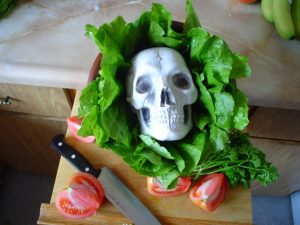Welcome to Washington, D.C., Frank, and government PR.
 On Nov. 20, the U.S. Food and Drug Administration and the Centers for Disease Control and Prevention warned the American public of a multi-state outbreak of E. coli O157:H7 linked to romaine lettuce and advised against eating any romaine lettuce on the market at that time.
On Nov. 20, the U.S. Food and Drug Administration and the Centers for Disease Control and Prevention warned the American public of a multi-state outbreak of E. coli O157:H7 linked to romaine lettuce and advised against eating any romaine lettuce on the market at that time.
According to FDA Commissioner Scott Gottlieb, M.D. and FDA Deputy Commissioner Frank Yiannas, we have new results to report from this investigation tracing the source of the contamination to at least one specific farm. Based on these and other new findings, we’re updating our recommendations for the romaine lettuce industry and consumers.
Today, we’re announcing that we’ve identified a positive sample result for the outbreak strain in the sediment of a local irrigation reservoir used by a single farm owned and operated by Adam Bros. Farms in Santa Barbara County.
The FDA will be sending investigators back to this farm for further sampling. It’s important to note that although this is an important piece of information, the finding on this farm doesn’t explain all illnesses and our traceback investigation will continue as we narrow down what commonalities this farm may have with other farms that are part of our investigation. While the analysis of the strain found in the people who got ill and the sediment in one of this farm’s water sources is a genetic match, our traceback work suggests that additional romaine lettuce shipped from other farms could also likely be implicated in the outbreak. Therefore, the water from the reservoir on this single farm doesn’t fully explain what the common source of the contamination. We are continuing to investigate what commonalities there could be from multiple farms in the region that could explain this finding in the water, and potentially the ultimate source of the outbreak.
 As of Dec. 13, our investigation yielded records from five restaurants in four different states that have identified 11 different distributors, nine different growers, and eight different farms as potential sources of contaminated romaine lettuce. Currently, no single establishment is in common across the investigated supply chains. This indicates that although we have identified a positive sample from one farm to date, the outbreak may not be explained by a single farm, grower, harvester, or distributor.
As of Dec. 13, our investigation yielded records from five restaurants in four different states that have identified 11 different distributors, nine different growers, and eight different farms as potential sources of contaminated romaine lettuce. Currently, no single establishment is in common across the investigated supply chains. This indicates that although we have identified a positive sample from one farm to date, the outbreak may not be explained by a single farm, grower, harvester, or distributor.
At the same time, the U.S. Centers for Disease Control updated its warning to advise U.S. consumers to not eat and retailers and restaurants not serve or sell any romaine lettuce harvested from certain counties in the Central Coastal growing regions of northern and central California. If you do not know where the romaine is from, do not eat it.
- Some romaine lettuce products are now labeled with a harvest location by region. Consumers, restaurants, and retailers should check bags or boxes of romaine lettuce for a label indicating where the lettuce was harvested.
-
- Do not buy, serve, sell, or eat romaine lettuce from the following California counties: Monterey, San Benito, and Santa Barbara.
- If the romaine lettuce is not labeled with a harvest growing region and county, do not buy, serve, sell, or eat it.
- The Public Health Agency of Canada has identified ill people infected with the same DNA fingerprint of E. coliO157:H7 bacteria in Canada.
-
